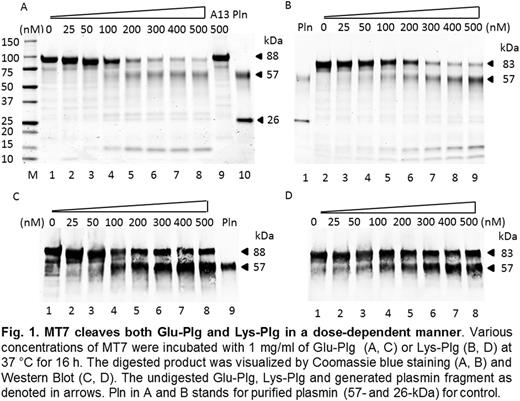Abstract
Background: ADAMTS13, a plasma metalloprotease, cleaves von Willebrand factor (VWF), thereby regulating normal hemostasis. While VWF is the only substrate identified to date, more evidence is emerging to indicate that ADAMTS13 may exert direct thrombolytic activity that cannot be fully explained by its known VWF-cleaving activity. We hypothesize that ADAMTS13 may directly interact with the fibrinolytic system to accelerate fibrinolysis; the distal carboxyl-terminal domains of ADAMTS13 may be important in determining its substrate specificity.
Objective: To determine the effect of full-length ADAMTS13 (FL-A13) and various carboxyl-terminally truncated ADAMTS13 variants in plasminogen activation and ultimate fibrinolysis.
Methods: Using biochemical and biophysical approaches to assess the proteolytic cleavage of plasminogen and fibrinogen/fibrin by ADAMTS13 and variants and binding interactions between plasminogen/fibrinogen and ADAMTS13 and variants.
Results: Coomassie blue staining and Western Blot assays demonstrated that a carboxyl terminally truncated ADAMTS13 variant (MT7) that was truncated after the 7th TSP1 repeat cleaved both Glu-plasminogen (Glu-Plg) and Lys-plasminogen (Lys-Plg) to form plasmin in a concentration and time-dependent manner (Fig. 1). MT8 (truncated after the 8th TSP1) and MS (truncated after the spacer domain) also cleaved both types of plasminogen but with much lower efficiency. Interestingly, full-length ADAMTS13 (FL-A13) did not show proteolytic activity towards plasminogen. The plasmin formed by MT7 is biologically active in proteolysis of fibrinogen in a time- and dose-dependent manner. The fibrinogen degradation product pattern, generated by MT7 and other carboxyl terminally truncated ADAMTS13 variants in the presence of plasminogen, was similar to those by tissue-plasminogen activation (t-PA). In addition, the plasmin formed by MT7 cleaved the peptidyl substrate S-2251 in a dose dependent manner. The MT7 and other carboxyl terminally truncated variants exhibited no direct proteolytic activity towards fibrinogen. When added to the preformed clot, MT7 was able to accelerate the lysis of the fibrin clot, initially slowly, but then rapidly as time progressed. The kinetics of fibrinolysis by MT7 was different from that of the t-PA control. Direct binding interactions between the carboxyl terminally truncated ADAMTS13 variants and plasminogen were then determined by surface plasmon resonance. MT7 bound to both types of plasminogen with similar affinities (KD of ~7 nM). However, FL-A13 did not bind to either Glu-Plg or Lys-Plg immobilized on a CM5 chip. Interestingly, when FL-A13 was immobilized on a CM5 chip, it bound to Lys- Plg but not Glu- Plg, but with 20-fold lower affinity compared to MT7. These results suggest that conformational change induced by ligand binding, proteolysis, or truncation may be necessary to expose ADAMTS13 binding site for plasminogen and alter its substrate recognition and specificity.
Conclusion: We are able to identify a novel substrate for ADAMTS13 ˗ plasminogen. The carboxyl terminal domains of ADAMTS13 appear to regulate the substrate specificity. These findings not only shed new light on the allosteric regulation of ADAMTS13 function but also provide rationale for the use of ADAMTS13 variants for a broader spectrum of thrombotic disorders including thrombotic thrombocytopenic purpura, ischemic cerebral stroke, myocardial infarction, as well as pulmonary embolism and deep vein thrombosis.
Zheng:Ablynx: Consultancy; Alexion: Research Funding.
Author notes
Asterisk with author names denotes non-ASH members.


This feature is available to Subscribers Only
Sign In or Create an Account Close Modal